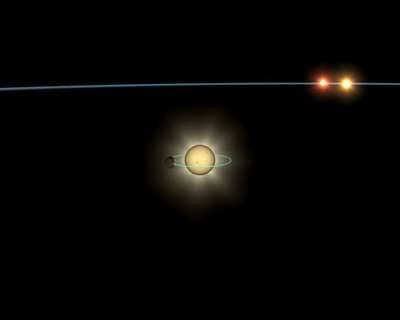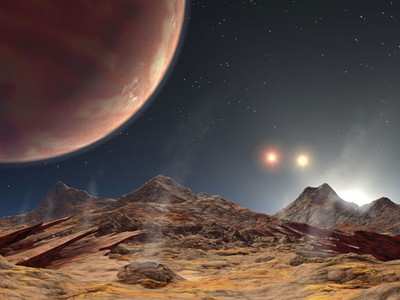Massive and Moving Fast
A NASA-funded astronomer has discovered a world where the sun
sets over the horizon, followed by a second sun and then a third.
The new planet, called HD 188753 Ab, is the first known to reside
in a classic triple-star system.

"The sky view from this planet would be spectacular, with an
occasional triple sunset," said Dr. Maciej Konacki (MATCH-ee
Konn-ATZ-kee) of the California Institute of Technology, Pasadena,
CA, who found the planet using the Keck I telescope atop Mauna Kea
mountain in Hawaii. "Before now, we had no clues about whether
planets could form in such gravitationally complex systems."
The finding, reported in this week's issue of Nature, suggests
that planets are more robust than previously believed.
"This is good news for planets," said Dr. Shri Kulkarni, who
oversees Konacki's research at Caltech. "Planets may live in all
sorts of interesting neighborhoods that, until now, have gone
largely unexplored." Kulkarni is the interdisciplinary scientist
for NASA's planned SIM PlanetQuest mission, which will search for
signs of Earth-like worlds.
Systems with multiple stars are widespread throughout the
universe, accounting for more than half of all stars. Our Sun's
closest star, Alpha Centauri, is a member of a trio.
"Multiple-star systems have not been popular planet-hunting
grounds," said Konacki. "They are difficult to observe and were
believed to be inhospitable to planets."
The new planet belongs to a common class of extrasolar planets
called "hot Jupiters," which are gas giants that zip closely around
their parent stars. In this case, the planet whips every 3.3 days
around a star that is circled every 25.7 years by a pirouetting
pair of stars locked in a 156-day orbit.
The circus-like trio of stars is a cramped bunch, fitting into
the same amount of space as the distance between Saturn and our
Sun. Such tight living quarters throw theories of hot Jupiter
formation into question. Astronomers had thought that hot Jupiters
formed far away from their parent stars, before migrating
inward.

"In this close-knit system, there would be no room at the
outskirts of the parent star system for a planet to grow,”
said Konacki.
Previously, astronomers had identified planets around about 20
binary stars and one set of triple stars. But the stars in those
systems had a lot of space between them. Most multiple-star
arrangements are crowded together and difficult to study.
Konacki overcame this challenge using a modified version of the
radial velocity, or "wobble," planet-hunting technique. In the
traditional wobble method, a planet's presence is inferred by the
gravitational tug, or wobble, it induces in its parent star. The
strategy works well for single stars or far-apart binary and triple
stars, but could not be applied to close-star systems because the
stars' light blends together.
By developing detailed models of close-star systems, Konacki was
able to tease apart the tangled starlight. This allowed him to
pinpoint, for the first time, the tug of a planet on a star
snuggled next to other stars. Of 20 systems examined so far, HD
188753, located 149 light-years away, was the only one found to
harbor a planet.
Hot Jupiters are believed to form out of thick disks, or
"doughnuts," of material that swirl around the outer fringes of
young stars. The disk material clumps together to form a solid
core, then pulls gas onto it. Eventually, the gas giant drifts
inward. The discovery of a world under three suns contradicts this
scenario. HD 188753 would have sported a truncated disk in its
youth, due to the disruptive presence of its stellar companions.
That leaves no room for HD 188753's planet to form, and raises a
host of new questions.
The masses of the three stars in HD 188753 system range from
two-thirds to about the same mass as our Sun. The planet is
slightly more massive than Jupiter.
 ANN's Daily Aero-Linx (12.03.25)
ANN's Daily Aero-Linx (12.03.25) ANN's Daily Aero-Term (12.03.25): CrewMember (UAS)
ANN's Daily Aero-Term (12.03.25): CrewMember (UAS) NTSB Prelim: Maule M-7-235A
NTSB Prelim: Maule M-7-235A Airborne-Flight Training 12.04.25: Ldg Fee Danger, Av Mental Health, PC-7 MKX
Airborne-Flight Training 12.04.25: Ldg Fee Danger, Av Mental Health, PC-7 MKX Aero-News: Quote of the Day (12.04.25)
Aero-News: Quote of the Day (12.04.25)




